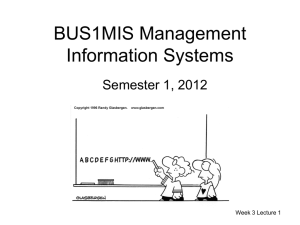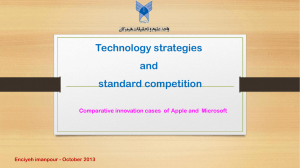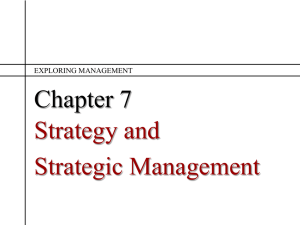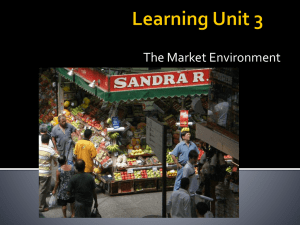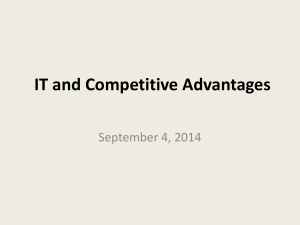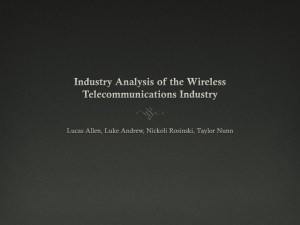Porter`s Strategy
advertisement
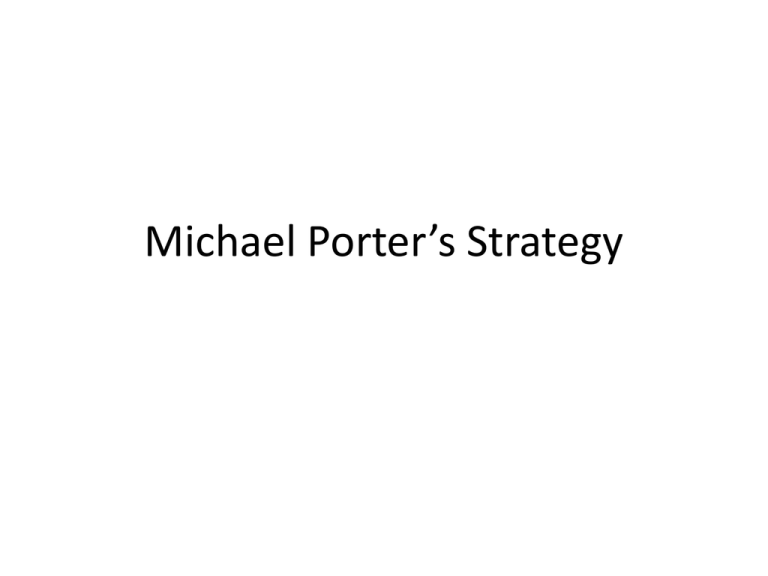
Michael Porter’s Strategy Critical Thinking May Be Overdone • “Meat, you’ve got to play this game with fear and arrogance.” • Reading with humility, reading with arrogance • Fear and ignorance Reading Porter Reading Porter for what there is to be learned, noting limitations along the way. There is much in Porter that is fundamental. We will read with humility and arrogance. “Competition is war and war is hell” This is Arthur Jerome Eddy, who published The New Competition in 1912. The book advocated avoidance of competition. He was a leader in the trade association movement. He was also one of the architects of the Federal Trade Commission. Like Porter, he didn’t much like competition Trade associations pursued “ethical behavior” among firms. Ethical behavior could include quality standards, fair business practices, and occupational licensing. Among other things, the movement advocated “ethical pricing.” Also known as price fixing. But I digress… An unfair slur on Michael Porter? Well, probably, yes. Porter’s economic policy v. Porters strategy Law and Social Welfare • Price fixing per se is illegal because in almost all instances it will be harmful. • Porter would not defend price fixing • Product variety, however, it perfectly legal and, in most instances, though not necessarily all, socially beneficial. Porter’s strategy does urge firms to avoid direct competition • The social consequences of product variety • Chamberlin, Robinson emphasized the social cost of variety. • Modern economics acknowledges benefits of variety, along with costs; a tradeoff. A brief non-technical introduction to oligopoly theory (again?) • Cournot (a peace treaty) • Bertrand (price war) • Stackleberg Leader Follower • Shared Monopoly Direct Competition • Cournot – Helped by product differentiation • Bertrand (price war) – Profits forced out • Stackleberg – Credible commitment to a market position • Shared Monopoly – A better peace treaty (also facilitated by product differentiation. ) “One-Upmanship is not a Strategy” • The bed wars • Free meals on flights (or bags, for that matter) • “Competing to be the best leads inevitably to a destructive game that no one can win.” • “The very essence of zero sum. • He is likening this to Bertrand price competition. And yet…. • New products and new features do arise • Automobiles came to include self starters, heaters, radios, air conditioners, etc, eventually as standard equipment • These can yield temporary competitive advantages • And then antilock brakes, traction control, stability control, lane departure warning, side monitoring, self parking…. We see this with • • • • • • • Restaurants Insurance Cameras Phones Mortgages Banking Pharmaceuticals An almost-general principle If a product improvement costs less to produce than the value that consumers place on the good, then introducing the improvement adds value. The first firm to implement a particular improvement will earn profits. Basic ideas in Porter that may seem obvious but are sometimes obscured p. 40 The fundamental equation: Profit = Price – Cost Or more correctly Unit Profit Margin = Price – Cost (in Magretta) And correctly: Profit = Total Revenue – Total Cost Avoiding what error in practice? • Market share (Why?) • Revenue (Why?) • And even unit margin (Why?) And yet these have their place. • Market share (Why?) • Revenue (Why?) • And even unit margin (Why?) And still, a simple useful message • Profit is the difference between • REVENUE • COST Structure determines profitability • That’s the core claim of Porter’s approach to strategy. “[I]ndustry structure determines profitability— not, as many people think, whether the industry is high growth or low, high tech or low, regulated or not, manufacturing or service. Structure trumps these other, more intuitive categories.” (p. 37) Those five forces… • • • • • Rivalry within the industry Threat of entry Threat of competition from substitutes Market power of suppliers Market power of customers Thinking critically • • • • • Rivalry within the industry Threat of entry Threat of competition from substitutes Market power of suppliers Market power of customers Thinking critically • • • • • Rivalry within the industry Threat of entry Threat of competition from substitutes Market power of suppliers Market power of customers Thinking critically • • • • • Rivalry within the industry Threat of entry Threat of competition from substitutes Market power of suppliers Market power of customers Thinking critically • • • • • Rivalry within the industry Threat of entry Threat of competition from substitutes Market power of suppliers Market power of customers Thinking critically • • • • • Rivalry within the industry Threat of entry Threat of competition from substitutes Market power of suppliers Market power of customers Competing for profits Selectively from Magretta; sidebar p. 61 “The real point of competition is earning profits, not taking business away from rivals. [but it is] …the tug of war over who gets to capture the value that an industry creates.” Competing for profits “Companies compete with their direct rivals, but also with their customers, their suppliers, potential new entrants and substitutes.” (Repeating the five forces) Competing for profits “The collective strength of the five forces determines the average profitability of the industry… . A good strategy produces a P&L better than this industry average baseline.” Competing for profits “Because industry structure can explain the income statements and balance sheets of every company in an industry, insights gained from it should lead directly to decisions about where and how to compete.” OK, maybe some critical thinking would be a good idea. Distinguishing between after the fact “explaining” versus predicting. Chapter 3: Competitive Advantage • The value chain: • The objective is to create value • Through lower cost, premium price, or both • As these occur in every aspect of the business Economic Fundamentals • ROIC (Return on invested capital) (in Porter) • Competitive advantage v. Comparative Advantage (not in Porter) Why return on invested capital? • Measures the efficiency of the use of resources. (Porter) • Ignoring capital investment distorts incentives, ignoring the capital investment of the firm • But the real reason is what investors seek, and this is how the firm must compete in the capital market. Porter says, compare within the industry. Why? But first, why not? Why shouldn’t se compare across industries? If industry A consistently earns lower returns on invested capital than industry B does, shouldn’t investors move capital out of industry A in favor or industry B? Answer: Yes, if true. But… It isn’t true. (not in Magretta) • Profits over book equity (invested capital) gives a distorted picture. Because… • Accounting depreciation rates do not reflect true economic depreciation rages. • Franklin Fisher, John McGowan, American Econ Review, 1983. A perpetuity • Pays $80 per year on a $1,000 investment. (no depreciation) Yields an 8% return. A one year project On a $1,000 investment, returns $ 1000, and another $80. (All depreciation accounted for in the year.) This too yields an 8% return. Now consider a thirty year project that yields a constant annual flow for thirty years, then yields nothing after that. Which is kind of like a mortgage. Principal (level payments, 30 years) 30 Years But now, look at accounting depreciation Principal Early, depreciation overstated, implied return understated Late, depreciation understated, profits overstated profit/asset severely overstated. 30 Years And the effects do not average out due to non linearity. Getting back to Porter • Firms in the same industry tend to have similar project duration structures. • So, Porter is right, it does make sense to compare within industries. • Though immature firms will face a different bias structure. The Value Chain: Premium Prices • “A company can sustain a premium price only if it offers something that is both unique and valuable to its customers.” • Product differentiation is anything that permits a higher price. • Moving away from perfect substitutes—creating a degree of market power More on Higher Prices • • • • • • • Greater value to customer Desirable features not found elsewhere Image Reliability or durability Convenience Style Affiliation Still More on Higher Prices • Deskilling home production – Meal in a box – Prefinished craft materials—e.g. wood flooring – Special tools for the semiskilled • Satisfying personal values – Environmental – Natural – Novel – Authentic The Value Chain: Lower costs • Internal process of the firm • Product efficiencies • Supply chain advantages • Location efficiencies Lower costs • Different product concept: – Take and Bake Pizza – Self serve anything – Salad Bar – Bring your own grocery bag – Reduced content—less powerful, fewer features (Just price discrimination?) – Generally, do it yourself (Or, its opposite, we do it for you, for a higher price) Lower Costs • Pack your own groceries (Aldi) • Select your own airplane seats (Southwest) • Make your own reservation: (Open table, Hotels.com) • Specify your own automobile (Several Manufacturers • Receive your bank or brokerage information online • Do your own investment research No Exhaustive List of Value Increasing Actions • Or, if we can list it, it doesn’t belong on the list • “The mind cannot foresee its own advance” (Hayek) And note the general problem, Any of these things that are readily observed by outsiders are readily imitated. Unless protected by patent or copyright, or possibly an important trademark, they may not provide a sustainable competitive advantage.

